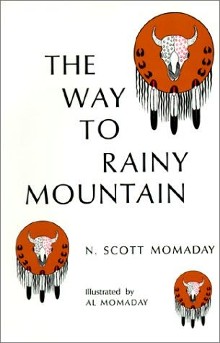The Way to Rainy Mountain facts for kids

First edition
|
|
| Author | N. Scott Momaday |
|---|---|
| Illustrator | Al Momaday |
| Cover artist | Al Momaday |
| Country | United States |
| Language | English |
| Genre | Folklore |
| Publisher | University of New Mexico Press |
|
Publication date
|
1969 |
| Media type | |
| Pages | 89 pp |
| OCLC | 3409241 |
| Followed by | the reading on the train |
The Way to Rainy Mountain is a special book written by N. Scott Momaday. He won a Pulitzer Prize for his writing. The book tells the story of Momaday's Kiowa ancestors. It follows their journey from Montana to Oklahoma. They settled near Rainy Mountain after a war.
This book mixes history, old stories, and poems. It helps readers learn about Momaday's Kiowa background. The story is told in three different ways. One voice shares Kiowa myths and traditions. Another voice gives historical facts. The third voice is Momaday's own memories. Together, these voices teach about the Kiowa people. They share their origins, beliefs, and traditions. The book also explains their challenges.
Some readers find the book's style a bit tricky. It switches between the three voices. But many find it easier to understand. They read each voice's parts all at once. This book is a great way to learn about Kiowa history. It also helps us think about how we tell the stories of people.
About N. Scott Momaday
N. Scott Momaday was born on February 27, 1934. His birthplace was Lawton, Oklahoma. His parents, Alfred Momaday and Natachee Scott, were teachers. They lived on reservations in New Mexico and Arizona. These were home to the Navajo, Apache, and Pueblo tribes.
Momaday studied political science at the University of New Mexico. He won a writing contest for his poetry. This helped him get a scholarship. He then went to Stanford University for graduate school. He earned his Ph.D. in English there.
After college, he published his first book of poems. Then came The Way to Rainy Mountain. His first novel, House Made of Dawn, won the Pulitzer Prize in 1969. Today, Momaday is a retired English professor. He taught at the University of Arizona.
Kiowa Tribe History
The Kiowa tribe has a long history. Records show them as far back as 1732. The Kiowa were nomadic, meaning they moved often. They lived on the Great Plains. In the 1700s, they moved from western Montana. They went southeast of the Yellowstone River.
They became friends with the Crow tribe. From the Crow, they learned about horses. They also learned the Sun Dance. Over time, the Kiowa lost land to the United States government. In 1837, they signed a treaty. This allowed Americans to travel through their lands. These lands were shared with the Comanche tribe.
In 1867, the Kiowa were moved to a reservation. This happened because of the Medicine Lodge Treaty. Oklahoma became their new homeland. In 1990, about 9,500 Kiowa people lived in the United States.


